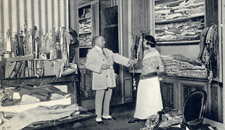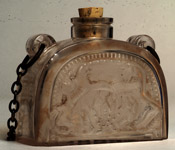Lightyears Collection
Parfums De Rosine
In 1911, fashion designer Paul Poiret set up two companies, one for each of his daughters. For Martine, the youngest, he established Les Ateliers de Martine. For Rosine, the eldest, he established Parfums de Rosine. Both enterprises flourished until Poiret fell victim to the stock market crash of 1929.
Les Ateliers de Martine trained talented girls from less fortunate families in the decorative arts. They were introduced to modern art and artists. They took sketching trips. They learned to weave and to decorate ceramics and glass. They also were involved in the creation of some of the bottles and packaging for Parfums de Rosine. Today many of the objects created by the "Martines" are valuable collectibles. Parfums de Rosine was a success from the beginning. François Coty is said to have tried to buy the company. Though details as to who worked on what project are sketchy, we do know that Poiret employed perfumers Emannuel Bouler (they are seen together in a photography), Maurice Shaller and Henri Alméras. Later Shaller created Carnet du Bal for Revillion (1937). Alméras created Joy (1930) and other fragrances for Jean Patou.
Besides the work of the Martines, package and advertising design was also suggested by artists employed by Poiret including Erté, Raul Duffy and Paul Iribe. Paul Poiret is regarded as the first fashion designer to bring out his own perfume. However, unlike Coco Chanel whose Chanel No. 5 first appeared in 1921 — ten years after Poiret had begun selling his "designer perfume" — Poiret never linked his name to either the names of his perfumes or to perfume company he had established for his daughter. Although precise records appear not to exist, it is known that many of Poiret's fragrances from about 1918 on were created by perfumer Henri Alméras who, after leaving Poiret, joined Jean Patou and numbered Joy among his creations for Patou. Vintage Parfums de Rosine FragrancesPlease note: much uncertainty surrounds this list. Your comments are welcome ... see below.
Relaunch Parfums de Rosine FragrancesThe Les Parfums de Rosine brand was reintroduced in 1991 by Marie-Hélène Rogeon with new fragrances created by François Robert. Modern creations include La Coupe d'Or, La Rose de Rosine, Le Muguet de Rosine, Rosine Mea Culpa, and Rose d'Homme. Additional Notes On Paul PoiretBorn in 1878, Poiret was the son of a Parisian cloth merchant. He developed a hobby of designing dresses. When he took tweleve of his creations to Madame Cheruit at the House of Raudnitz Soeurs, she bought them all. In 1899 he joined Doucet, who entrusted him with dressing prestige clients, but he was also selling designs to Redfern and Maggy Rouff. In 1900 Poiret served briefly in the army, then returned to Paris. In 1901 he joined the House of Worth which was now in the hand of Charles Frederick Worth's sons. In 1904 he opened his own fashion house at 5, rue Auber. The following year he married Denise, who became one of his best models. Poiret's business expanded greatly until the eve of World War I. In 1914 he closed his fashion business and joined the army again. The heart of his business remained closed until he returned in 1918, the war being over. From 1921 to 1925, Poiret opened shops in Cannes, Deauville (when Chanel was making her name), Biarritz and La Boule but Poiret's approach to fashion was going out of favor with women and, after 1925, his business went into decline. His wife divorced him, he declared bankruptcy in 1929, and he died impoverished and forgotten in 1944. —— ## ——
If you have any information you would like to share with us about Parfums de Rosine or Paul Poiret, please use the message sender below. |
|


Philip Goutell
Lightyears, Inc.



